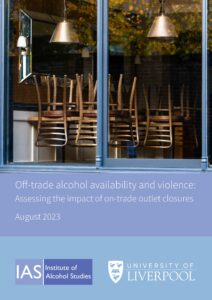View this report

There is strong and consistent evidence that on-trade alcohol availability is related to violence, but evidence regarding a similar association between off-trade availability and violence is more mixed.
Partly, this is because it can be difficult to disentangle the effects of off-trade (e.g., supermarkets, off-licences) and on-trade (e.g., pubs, bars) availability because consumer decisions and behaviours can be affected by both.
Further, while violence is a reasonably common outcome measure in availability studies, domestic violence is less commonly investigated.
In England, COVID-19 restrictions significantly altered alcohol availability nationwide, with periods in which access to on-trade premises like pubs and restaurants was closed off entirely. This unique situation, while complicated by other effects of the pandemic, presents a novel opportunity to isolate and examine the impact of off-trade availability on alcohol-related violence.
Police-recorded violent crime data was used to explore changes in the proportion of alcohol-related (i) violence as well as (ii) domestic violence using growth curve models.
Average monthly alcohol-related violence rates were higher when on-licensed premises were open, compared to periods in which they were closed.
In months of on-trade closure, the proportion of violence which was recorded as alcohol related fell by 2.7 percentage points (from 15.5% to 12.8%; or, on average, 89 fewer alcohol-related incidents a month).
On-trade closures did not lead to significant differences in levels of alcohol-related domestic violence, nor in the proportion of domestic violence which was recorded as alcohol-related.
The findings suggest attempts to address alcohol-related violence cannot solely consider on-trade settings – especially those interventions targeting alcohol-related domestic violence.
View this report
